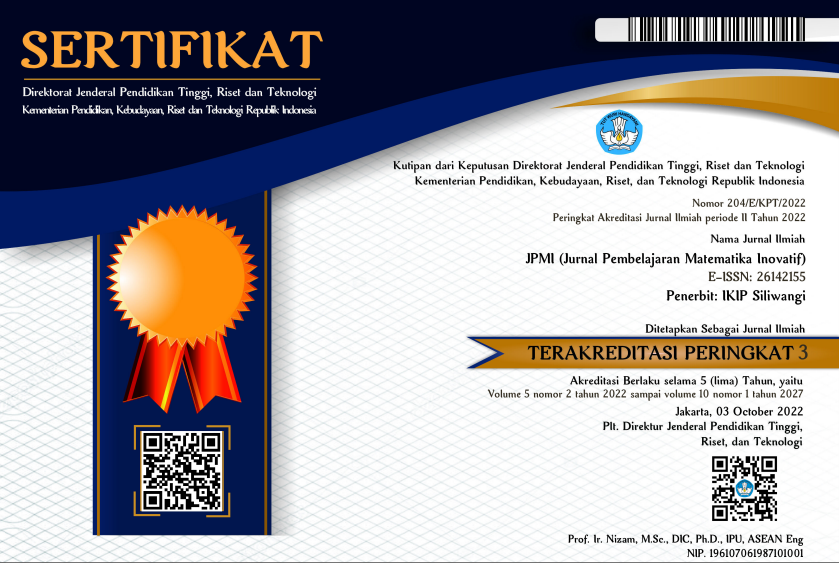KEMAMPUAN BERPIKIR KREATIF MATEMATIS SISWA SMPN 02 MERAL
DOI:
https://doi.org/10.22460/jpmi.v5i1.p%25pKeywords:
Analysis, Creative Thinking, Mathematical Creative ThinkingAbstract
This study aims to describe the mathematical creative thinking skills of SMPN 2 Meral students on the material of flat side space. This type of research is descriptive with a quantitative approach. The data collection technique used is in the form of a written test in the form of questions about the material for building flat sides, documentation, and interviews. This study uses qualitative descriptive data analysis techniques, namely: (1) data reduction; (2) triangulation of data; (3) analyzing the results of written tests and interviews; (4) Drawing conclusions. This research focuses on 4 aspects, namely: (1) Fluency; (2) Flexibility; (3) Elaboration (elaboration); and (4) Authenticity (originality). The results of this study indicate that students' creativity in answering fluency indicator questions is 66.6% which is included in the creative category, 83.3% flexibility indicator questions which are very creative, and elaboration indicator questions are 41.6 % which is categorized as quite creative, 79.1% of originality indicators are included in the creative category, and the average percentage of creative thinking for class IX students at SMPN 2 Meral is 67.65% in the creative category.
References
Andiyana, M. A., Maya, R., & Hidayat, W. (2018). Analisis kemampuan berpikir kreatif matematis siswa smp pada materi bangun ruang. JPMI (Jurnal Pembelajaran Matematika Inovatif), 1(3), 239–248. https://doi.org/10.22460/jpmi.v1i3.p239-248
Apriliani, L. R., & Suyitno, H. (2016). Kemampuan berpikir kreatif matematis berdasarkan kecemasan matematika pada pembelajaran creative problem solving berteknik SCAMPER. Unnes Journal of Mathematics Education Research, 5(2), 131–138.
Aripin, U., & Purwasih, R. (2017). Penerapan Pembelajaran Berbasis Alternative Solutions Worksheet Untuk Meningkatkan Kemampuan Berpikir Kreatif. AKSIOMA: Jurnal Program Studi Pendidikan Matematika, 6(2), 225. https://doi.org/10.24127/ajpm.v6i2.989
Azhar, W. S., & Senjayawati, E. (2021). Analisis Kesalahan Siswa SMK dalam Menyelesaikan Soal Materi Geometri Ruang. JPMI (Jurnal Pembelajaran Matematika Inovatif), 4(1), 185–192.
Azzahra, F. (2021). Analisis tipe kesalahan siswa berdasarkan Newman’s Error Analysis (NEA) ditinjau dari kemampuan koneksi matematis: Penelitian kualitatif di SMPN 1 Sumedang. UIN Sunan Gunung Djati Bandung.
Hanipah, N., Yuliani, A., & Maya, R. (2018). Analisis Kemampuan berpikir kreatif matematis siswa MTs pada materi lingkaran. AKSIOMA: Jurnal Program Studi Pendidikan Matematika, 7(1), 80–86.
Mahmudah, W. (2018). Analisis kesalahan siswa dalam menyelesaikan soal matematika bertipe Hots berdasar Teori Newman. Jurnal UJMC, 4(1), 49–56.
Munawaroh, N., Rohaeti, E. E., & Aripin, U. (2018). Analisis kesalahan siswa berdasarkan kategori kesalahan menurut watson dalam menyelesaikan soal komunikasi matematis siwa SMP. JPMI (Jurnal Pembelajaran Matematika Inovatif), 1(5), 993–1004.
Novilanti, F. R. E., & Suripah, S. (2021). Alternatif Pembelajaran Geometri Berbantuan Software GeoGebra di Masa Pandemi Covid-19. Jurnal Cendekia: Jurnal Pendidikan Matematika, 5(1), 357–367. https://doi.org/https://doi.org/10.31004/cendekia.v5i1.538
OECD. (2018). PISA 2015 results in focus. Programme for International Student Assessment. 1–32.
Putri, C. A., Munzir, S., & Abidin, Z. (2019). Kemampuan berpikir kreatif matematis siswa melalui model pembelajaran brain-based learning. Jurnal Didaktik Matematika, 6(1), 12–27.
Rahmatiya, R., & Miatun, A. (2020). Analisis kemampuan pemecahan masalah matematis ditinjau dari resiliensi matematis siswa SMP. Teorema: Teori Dan Riset Matematika, 5(2), 187–202. https://doi.org/10.25157/teorema.v5i2.3619
Rasnawati, A., Rahmawati, W., Akbar, P., & Putra, H. D. (2019). Analisis Kemampuan Berfikir Kreatif Matematis Siswa SMK Pada Materi Sistem Persamaan Linier Dua Variabel (SPLDV) Di Kota Cimahi. Jurnal Cendekia : Jurnal Pendidikan Matematika, 3(1), 164–177. https://doi.org/10.31004/cendekia.v3i1.87
Setiawati, F. N., Widadah, S., & Agustina, E. N. S. (2020). Representasi Matematis Siswa SMP Berkemampuan Tinggi dalam Menyelesaikan Soal Matematika. Indonesian Journal of Mathematics and Natural Science Education, 1(2), 111–120. https://doi.org/10.35719/mass.v1i2.35
Sumartini, T. S. (2019). Kemampuan Berpikir Kreatif Mahasiswa melalui Pembelajaran Mood , Understanding , Recall , Detect , Elaborate , and Review Mosharafa : Jurnal Pendidikan Matematika Mosharafa : Jurnal Pendidikan Matematika. Mosharafa: Jurnal Pendidikan Matematika, 8(1), 13–24.
Suripah, S., & Retnawati, H. (2019). Investigating Students’ Mathematical Creative Thinking Skill Based On Academic Level And Gender. International Journal of Scientific &Technology Research, 8(8, Agustus 2019), 227–231.
Suripah, S, & Sthephani, A. (2017). Kemampuan berpikir kreatif matematis mahasiswa dalam menyelesaikan akar pangkat persamaan kompleks berdasarkan tingkat kemampuan akademik. Pythagoras: Jurnal Pendidikan Matematika, 12(2), 149–160. https://doi.org/10.21831/pg.v12i2.16509
Ulandari, N., Putri, R., Ningsih, F., & Putra, A. (2019). Efektivitas model pembelajaran inquiry terhadap kemampuan berpikir kreatif siswa pada materi Teorema Pythagoras. Jurnal Cendekia: Jurnal Pendidikan Matematika, 3(2), 227–237. https://doi.org/10.31004/cendekia.v3i2.99
Yolanda, F. (2021). Analisis Kesalahan Mahasiswa Pendidikan Matematika UIR pada Penyelesaian Analisis Kompleks. 5(1), 32–42. https://doi.org/10.35706/sjme.v5i1.4393.
Downloads
Additional Files
Published
Issue
Section
License
Copyright (c) 2022 JPMI (Jurnal Pembelajaran Matematika Inovatif)

This work is licensed under a Creative Commons Attribution-ShareAlike 4.0 International License.
The author is responsible for acquiring the permission(s) to reproduce any copyrighted figures, tables, data, or text that are being used in the submitted paper. Authors should note that text quotations of more than 250 words from a published or copyrighted work will require grant of permission from the original publisher to reprint. The written permission letter(s) must be submitted together with the manuscript.
















